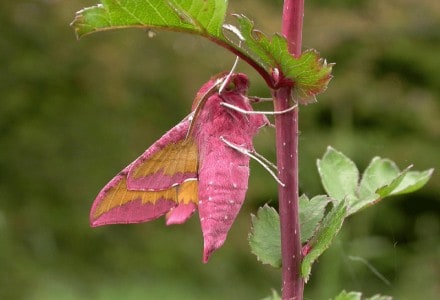
Elephant Hawk Moth Facts
- The unusual term of Elephant Hawk Moth serves as only one of the common names applied to this magnificent Lepidoptera. The other term often used for it’s actually very similar in nature. That’s the redundant term of Large Elephant Hawk Moth.
- Its formal scientific name, meanwhile, remains that of the hard to pronounce Deilephila elpenor. The highly respected Swedish botanist and naturalist Carl Linnaeus made that first recognition of the species. He accomplished this in the year 1758.
- Both of the distinctive, and confusing, common names spring from the same source. That’s because their origins lie in the appearance of the larval form of the invertebrate. This occurs because many people feel this form resembles the trunk of an elephant.
- The fabulous Elephant Hawk Moth also stands out from many of its peers for another, unrelated reason. For the moment, its population numbers appear to be both sufficient and stable. This further holds true throughout the entirety of its range.
- The IUCN, therefore, presently has no listing for the arthropod on its Red List of Threatened Species. The marvelous creature nonetheless likely faces several potential threats. Like many species, these primarily consist of habitat loss and climate change.
Related Articles
Luna Moth Comet Moth Cecropia Moth
Elephant Hawk Moth Physical Description
The magnificent Elephant Hawk Moth, despite the term, impresses for reasons other than sheer physical size. That’s because, from that perspective, it’s only average-sized. It does, however, differ physically from most moths in one certain way.
That’s due to the fact that, unlike many related creatures, it displays no appreciable sexual dimorphism. That’s not to say that no differences in the genders exists, of course. Physical variations between the sexes do occur, but usually remain too small to notice.
Typically, a mature individual has a wingspan measuring roughly 2-2.8 in (50-70 mm). This variety of Lepidoptera also evolved as spectacularly colored. In point of fact, the gorgeous insect appears to the eye to shimmer with green and red when in motion.
The thorax and head of the Elephant Hawk Moth, furthermore, developed as segmented. This section of the body also develops as quite slender, at least when compared to the rest of its body. Its legs also generally develop as extremely thin and colored bright white.
- Kingdom: Animalia
- Phylum: Euarthropoda
- Class: Insecta
- Order: Lepidoptera
- Family: Sphingidae
- Genus: Deilephila
- Species: D. elpenor
Photographer: gailhampshire
CC License: https://bit.ly/1ryPA8o
Elephant Hawk Moth Distribution, Habitat, and Ecology
The visually stunning Elephant Hawk Moth has yet another factor working in its favor. That’s because it evolved as endemic to a comparatively wide region of the globe. Amazingly, this zone of habitation actually extends through large sections of both Europe and Asia.
Within this extremely large zone, it appears in regions including Ireland and Great Britain, as well as much of, Russia. It may also be present in northern parts of the Indian subcontinent, Korea, and Japan. Evidence for this exists, but remains inconclusive for now.
It’s also been introduced into other parts of the world. This occurred via the actions of man, both intentionally and unintentionally. The gorgeous arthropod therefore now appears even in portions of North America. There, it’s been spotted in British Columbia, in Canada.
In most portions of its native range, the adults appear from May to July. The marvel of Nature also quite often appears in urban settings in the evening. There, it’s frequently observed feeding in parks and even home gardens. It’s therefore proven to be adaptable.
The caterpillars further live from July to September, at which time when these usually pupate. The remarkable arthropod will also sometimes produce two broods in a year. This provides the invertebrate a distinct advantage over many related species.
The adult Elephant Hawk Moth primarily feeds at night in the wild. It modifies that in urban areas, however. Like many types of moth, though, it has preferred food sources. Thus, it often takes nectar from garden plants like honeysuckle and petunias.
Species Sharing Its Range
Snowy Owl Scottish Wildcat English Oak
Check out our other articles on Incredible Sharks of the World, Bee Hummingbird, Ha Long Bay, Hawaiian White Hibiscus, Yangtze River Dolphin, Texas Horned Lizard

